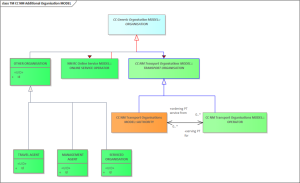FAQ Transmodel
Conceptual modelling – separating concerns & identifying analogies
ORGANISATION DAY TYPE
What is it really used for and why is it modeled so complex?
Transmodel provides the concept of DAY TYPE defined as a type of day characterised by one or more properties which affect public transport operation. For example: weekday in school holidays.
This concept is intended to be used by organisations (in particular operators) in charge of the planning of public transport services.
Transmodel provides the following types of organisations:
A TRANSPORT ORGNISATION is providing transport services related to particular modes of operation.
Other types of organisations exist, in particular SERVICED ORGANISATIONs which are public or private organisations for which public transport services are provided on specific days, e.g. a school, university or works.
ORGANISATION DAY TYPE is a DAY TYPE that is defined in terms of operation or not operation of a referenced SERVICED ORGANISATION (specific DAY TYPE).
This concept is used to describe a reality proper to an organisation serviced by public transport.
Example:
PT services are defined for DAY TYPES Monday, Tuesday, Wedenesday, Thursday, Friday. Some schools in France are closed on Wedensdays, so the service is not required on Wednesdays.
In this case we have ORGANISATION DAY TYPEs:
· Monday-Tuesday-Thursday-Friday characterised by 'isServiceDay' = true and
· Wednesday charactrised by ' isServiceDay '= false.
The additional attribute 'isServiceDay' is present in NeTEx.
INDIVIDUAL PASSENGER INFO
Why is INDIVIDUAL PASSENGER INFO not just a structure within INDIVIDUAL TRAVELLER?
An INDIVIDUAL TRAVELLER may be a driver (e.g. in car pooling) or a passenger .
Therefore we have both: INDIVIDUAL PASSENGER INFO and VEHICLE POOLING DRIVER INFO.
Here, the roles of an INDIVIDUAL TRAVELLER are separated and the attributes reflect the main requirements/characteristics related to each role.
NB: the list of attributes reflects the MAIN characteristics allowing to describe the semantics of a concept – NeTEx provides in may cases some more properties.
